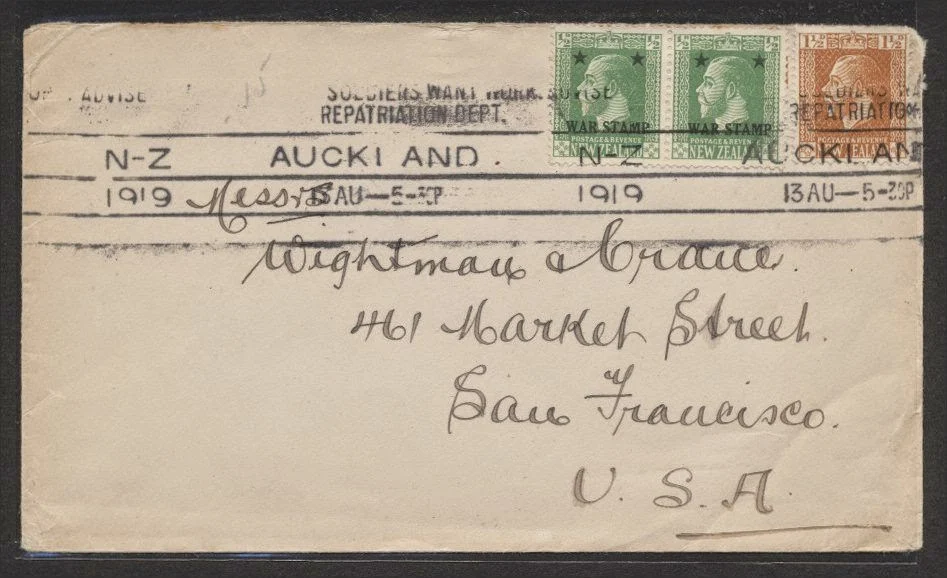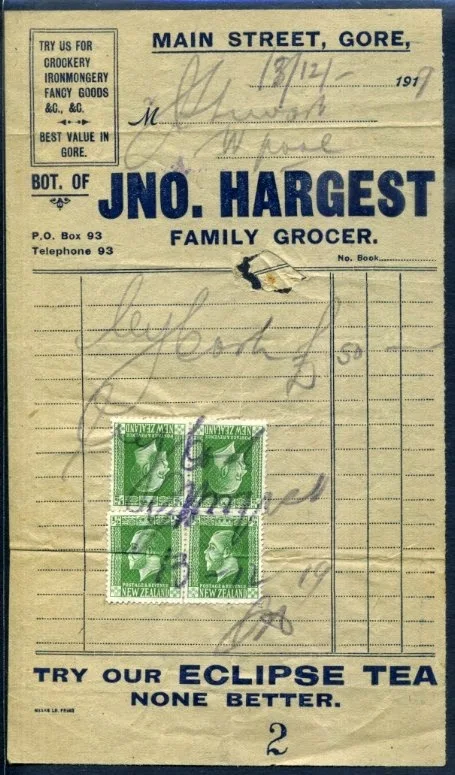Definitive Issue.

 The King Edward VII stamps had only been on issue for six months when he died in 1910 and his son King George V ascended to the throne. It was quickly decided that a new set of stamps should replace the Edward VII stamps, but it would be five years before the new set was issued. There were various reasons for the five year delay - difficulty finding a designer, difficulty sourcing appropriate inks, and the perfectionist nature of the then Postmaster-General Sir Heaton Rhodes, himself a keen philatelist. Rhodes was keen to return to the simplicity of the 1855 Chalon Heads and the English 1840 penny black and two pence blue stamps. If you compare the George V stamp on the left with the English 1d Black on the right, you can see how closely they resemble each other.
The King Edward VII stamps had only been on issue for six months when he died in 1910 and his son King George V ascended to the throne. It was quickly decided that a new set of stamps should replace the Edward VII stamps, but it would be five years before the new set was issued. There were various reasons for the five year delay - difficulty finding a designer, difficulty sourcing appropriate inks, and the perfectionist nature of the then Postmaster-General Sir Heaton Rhodes, himself a keen philatelist. Rhodes was keen to return to the simplicity of the 1855 Chalon Heads and the English 1840 penny black and two pence blue stamps. If you compare the George V stamp on the left with the English 1d Black on the right, you can see how closely they resemble each other.
The initial issue contained the 1½d, 2d violet, 2½d, 3d, 4d yellow, 4½d, 6d, 7½d, 9d and 1/- stamps. The 1½d, 4½d and 7½d stamps were new values introduced for parcel post and it was not thought necessary to have 5d and 8d values. All this careful planning came unstuck when World War I began and a halfpenny tax was imposed on all mail other than newspapers. As the new issue did not have 5d or 8d stamps, the Edward VII issue stamps continued in use until 1922 when 5d and 8d recess print stamps were finally introduced. However, within a week of issue of the 8d blue it was realised that the colour was too easily confused with the 2½d stamp, so the stamp was reprinted brown as the 7½d brown stamp had been withdrawn by that stage. This ought to have made the 8d blue stamp very rare, but pressure from stamp collectors forced the post office to continue selling the stamps.
In 1915 the tax on receipts was increased to 2d. The 2d violet stamp was too dark for pen cancellations to show up, and so the colours of the 2d violet and 4d yellow were swapped in 1916. Many used copies of the 4d yellow were cancelled after it was withdrawn and 1915 cancellations are hard to find.
1915 - King George V
Recess-Printed Stamps.
1½d - Grey. 2d - Violet. 2d - Yellow (1916).
2½d - Blue. 3d - Brown/Chocolate.
4d - Yellow. 4d - Violet (1916). 4½ - Green.
5d - Blue (1922). 6d - Red.
7½d - Brown. 8d - Blue (1921). 8d - Brown (1922).
9d - Olive Green. 1/- - Orange.
1915 - King George V
Recess-Printed Officials.
At the same time six values were overprinted with the word 'OFFICIAL' for the use of Government Departments.
3d - Brown/Chocolate. 4d - Violet (1916). 6d - Red.
8d - Brown (1922). 9d - Olive Green. 1/- - Orange.
1915 King George V
Local Printing.
Surface printing of the 1½d stamp was introduced during the First World War to reduce costs and because the halfpenny war tax on all mail except newspapers had led to unexpected demand for this value. The original recess printed 1½d stamp had been intended for parcel rates, not standard mail.
The surface printed 1½d stamp was printed using a plate engraved locally by W.R. Bock. However, the stamps were not up to the required standard and were replaced by plates produced by Perkins, Bacon in London along with the 2d and 3d plates in the 'King George V Surface Print' issue.
1½ - Grey/Black. 1½ - Grey/Black Official.
1915 King George V
Surface Printed.
The halfpenny stamps were surface rather than recess printed to save costs because of the larger quantities expected. Surface printing, which is much less expensive than recess printing, had only been intended for the halfpenny green stamp. However, cost savings during the First World War combined with the halfpenny war tax led to unexpected demand for slightly higher values and the decision was made to surface print the other values in this set as well.
The grey black surface printed 1½d stamp replaced the 'local' surface print (See 1915 King George V Local Print issue above) which were not engraved with sufficient accuracy. Perkins, Bacon in London produced new 1½d plates at the same time as the new 2d and 3d plates were produced. The colour of the 1½d stamp was later changed from grey black to orange brown because light cancellations did not show up on the original stamp.
½d - Olive Green. 1½ - Grey/Black. 1½ - Orange/Brown.
2d - Yellow (1916). 3d - Brown/Chocolate.
1915 King George V
Surface Printed Officials.
The five surface printed stamps were also overprinted for Official use.
To view all the 'Official stamps produced by New Zealand visit An Official Post.
½d - Olive Green. 1½ - Grey/Black.
1½ - Orange/Brown. 2d - Yellow (1916). 3d - Brown/Chocolate.
2d Yellow Official
No dot after the word "OFFICIAL"
1915 King George V
War Stamp.
The halfpenny stamps were surface rather than recess printed to save costs. During the First World War, in 1915, a halfpenny war tax was introduced on all mail other than newspapers and the halfpenny stamp was overprinted 'WAR STAMP' to explain why postal rates had increased.
½d - Olive Green.
War Tax.
The recess print stamps have a different design to the surface and local print stamps which are listed separately. The recess print stamps (left image) have diagonal shading on George V's face and neck, while the surface print stamps (middle image) have horizontal shading. The background on the surface prints has a clear diagonal pattern, while the recess print stamps have a very fine and complex pattern of alternating arcs with a criss-cross hatching over the top giving the appearance of almost solid shading. The local print (right image) is very coarsely drawn with a diagonal pattern very similar to the surface print stamps, but with rather poorly spaced diagonal shading lines on the face and neck.
Postage & Revenue.
These stamps all carried the words 'Postage & Revenue' meaning they were intended for both purposes. Below is a small collection of covers and documents showing examples of their use.
A registered cover posted from Christchurch to Dunedin on 10th May, 1917. The stamps used are 1d Dominion, 5d George V & 2d George V. This appears to have been a commercial cover but the company name has been covered by the Registration Label.
A 1919 cover ½d War stamp pair & 1½d George V Brown giving a total postage of 2d plus ½d War Tax. The letter was sent from Auckland to USA on 13th August, 1919. The main reason I've included this cover is as an example of machine cancelling.
Here we have a registered cover sent Dunedin to the USA. It has fairly clear franking over a pair of with 1½d George V Brown, Surface Print plus a 1d Dominion.
Our next item is a 1929 Mail Tag. It has a very clear and bold cancel over a pair of 1/- Orange. Notice the Parcel Post label as a bag of mail would be considered a parcel rather than single letters.
This is an example of revenue use where this invoice required a 2d yellow GV Recess as stamp duty. The Invoice from J. Rattray & Son Ltd. of Invercargill was dated 21st Sept, 1916. This is a very good example of a hand written document. Notice how the items were added up to a total of 54pounds,seven shillings and seven pence. It then appears two other invoices, maybe out-standing were added to this one making a total of 90pounds, 14shillings and 3pence.
A 1919 Receipt from the Gore Grocery Shop for 50pounds The stamp duty paid was 2d made up from 2 pairs of George V ½d green.
A George V 2d purple used as Revenue on a 1916 Receipt. See how hard it was to read the dating and signing on this stamp. That is why some stamp used for Revenue purposes were changed to lighter colours.
Now here is a real find for a collector of postal stationary. It is a 1916 letterhead from the Northern Assurance Company, a cover with a George V 1½d Black and a business reply postcard. The three items could be nicely displayed together in a collection.
King George V Admirals.
The 1926 Admirals are often included with the 1915 definitive issue as they were intended to be an add-on to that original issue. For that reason I have decided to include them here but I plan to feature them in greater detail in their own page. It seems the guy on the red stamp wearing a lamp shade hat is the king dressed as a Field Marshall. The guy on the larger values is the king again but now dressed as Admiral of the Fleet.
The former Governor-General, Viscount Jellicoe, had been the commander of the British fleet at the Battle of Jutland in 1916, and so it was decided that the two and three shilling stamps would feature a portrait of King George V wearing the uniform of Admiral of the Fleet. General Sir Charles Fergusson, who had succeeded Viscount Jellicoe as Governor-General, was a distinguished soldier so the penny stamp was designed depicting King George V in the uniform of an Army Field Marshall.
1d - Field Marshall. 2/- Blue Admiral. 3/- Violet Admiral.
1d - Field Marshall. 2/- Blue Admiral.
Some of the images in this post were used with permission from the illustrated catalogue of StampsNZ


















































Hey Mary,
ReplyDeleteThis was a good read. Many times the King George V definitives are looked upon as boring. You did a good job of them. I must add that I learnt a couple of things today. First, I did not realise that this issue was so complex, even extending to different printing methods. Secondly, I did not know how to easily tell these stamps apart.
But your comment on the Admirals, did I laugh. I just want to know what King George would have thought of being told he was wearing a lamb shade. LOL That is what I like about your writing Mary.
Andrew.
Well doesn't it look like that Andrew? Looks like a lamb shade to me!
DeleteI have been working on a page about the Admirals so I copied a paragraph here explaining the ideas behind these designs. Expect this new page to be published when Allan clears it.
Glad you got something out of my work here. Thanks for telling me.
Mary.
So should the Admirals be included as part of the George V definitives or should they be kept separate?
DeleteDeeDee.
The definitives were issued in 1915 and the Admirals in 1926. They are really two separate issues. I think the reason they get included together is because they are both considered to be King George V definitives.
DeleteBC
Yes I agree BC
DeleteI first intended to leave the Admirals off this page until some readers mentioned it should be included.
Now they are included here and are featured on their own page.
Mary
Nice post. You have done a great job explaining this series.
Delete